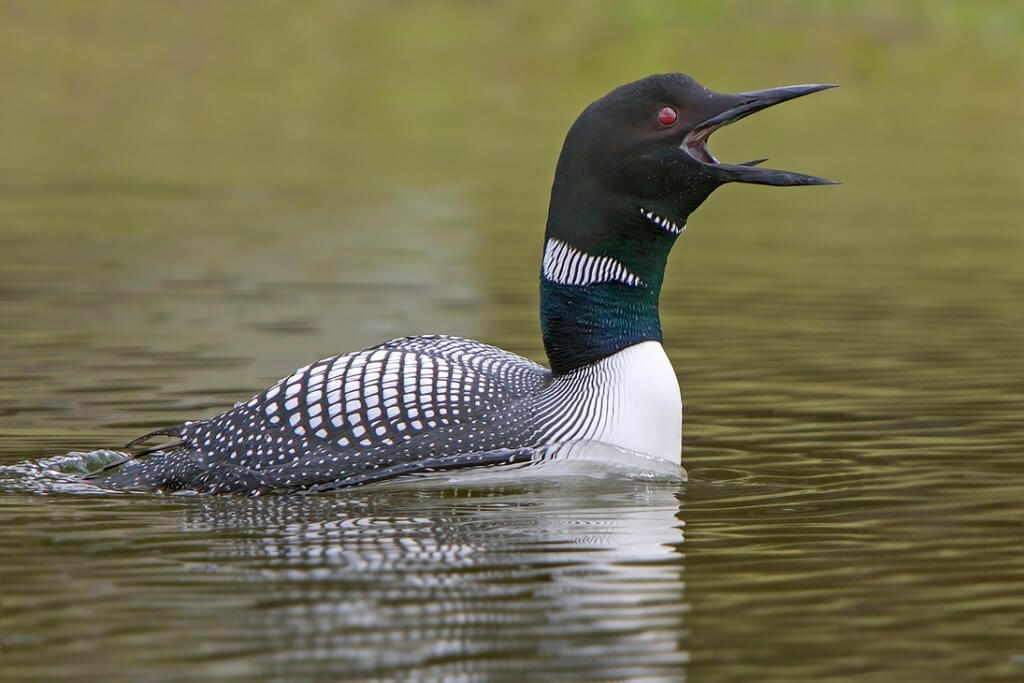Staking out Territory: Loons on Kintla Lake
by Ginn Barber
Broadcast 9.7 & 9.10.2021

Common Loon vocalizing, photo by Alan D. Wilson, CC 3.0, naturespicsonline.com.
Listen:
A decidedly chilly morning found my husband and I trundling along a distant gravel road, watching steely dawn give way to golden light. Our vehicle bounced its way toward Kintla, a corner of Glacier National Park we were eager to see again. It was easy to tell that summer was gone by the handful of tents left. When we finally arrived, the sky crowded in, bringing a fine drizzle.
We explored the shoreline, enchanted by colorful rocks and the lake’s smooth surface, barely marred by light rain. Soon enough, a small brace of ducks announced their arrival, piercing through the soft silence. They were comical to behold, bodies sleeker than mallards, swanning around with their rusty heads held high, feathers swept back like eighties teenagers armed with cans of hairspray. Common mergansers, I’d find out later. New to birding as we were, they were anything but common to us.
We watched as six or seven mergansers dove beneath the surface, leaving us to ponder the lone female left paddling about, often ducking its head underwater. The lookout, we both joked, as we wondered why she was so diligent about checking her flock. The lake remained still as they took turns diving, leaving a lone sentinel.
The rhythm shattered suddenly, the ducks frantically resurfacing and taking off in an uproar, disappearing somewhere southeast. We scanned the lake. Nothing. Other than the mergansers’ wake, the water seemed calm. What on earth could have frightened them off?

Common Loon, photo by Elaine R. Wilson, CC 3.0, naturespicsonline.com.
Another moment slipped by before a sleek, dark form rocketed up from the depths. An angry phoenix, the new bird appeared stretching its wings, repeatedly slapping the surface as it kept launching its body upright, almost leaping out of the water. All the while, it called out, the trembling sound of a woodwind instrument bouncing off the dense bowl of that valley. “I’ve never seen a loon do that before,” a camper commented from behind us. He sidled up next to my husband, talking softly as we all admired the bird’s prolonged display.
This was a loon? I thought to myself. This repeated warbling wasn’t anywhere near that lovely, haunting sound I once heard from a recording. And was all this slapping and calling a loon’s territorial display? Thankfully, my husband pulled out his phone to record it. That was autumn of 2017.
Later, our photos of the loon’s dark head and beak, along with its checkered back confirmed that we saw a common loon in its breeding plumage. A bit more searching led me to a video series from Cornell University called Understanding Loons. There I discovered that loons have three main types of vocalizations: the wail, the tremolo, and the yodel. Another website included a softer vocalization called the hoot.
A loon’s wail is that quintessential sound one associates with clear lakes and misty mornings, that slow, lingering trio of notes as it calls out to a mate or its chicks. Loon.org states that wails are long distance calls between mated pairs. It also mentions the much softer hoot, used for communicating within shorter distances amongst loon family members. The yodel, on the other hand, is a call with an introduction followed by repeating syllables solely performed by male loons while defending territory.
What we heard that morning was the tremolo, a high-pitched wavering call thought to be a sign of agitation when a loon feels threatened. The call brought to mind a flutist’s ring finger rapidly pressing a key in quick succession. And that display we witnessed with the loon lurching out of the water brandishing its wings? That was a variation of the penguin dance, a threatening display to ward off intruders.
We found ourselves back at Kintla a few years later. There, we saw another loon silently scudding along the lake. It reminded me once more of that wondrous autumn day years ago. I now knew that if anything got too close to its peaceful paddling or broke the loon’s invisible perimeter, it was ready to stake out its territory, wings spread wide, fiercely claiming that lake his.
Every week since 1991, Field Notes has inquired about Montana’s natural history. Field Notes are written by naturalists, students, and listeners about the puzzle-tree bark, eagle talons, woolly aphids, and giant puffballs of Western, Central and Southwestern Montana and aired weekly on Montana Public Radio.
Click here to read and listen to more Field Notes. Field Notes is available as a podcast! Subscribe on iTunes, Google Play, or wherever you listen to podcasts.
Interested in writing a Field Note? Contact Allison De Jong, Field Notes editor, at adejong [at] montananaturalist [dot] org or 406.327.0405.
Want to learn more about our programs as well as fun natural history facts and seasonal phenology? Sign up for our e-newsletter! You can also become a member and get discounts on our programs as well as free reciprocal admission to 300+ science centers in North America!












